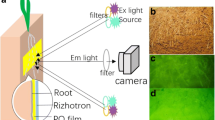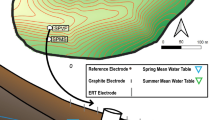Abstract
The root-zone of wetland rice was monitored in a paddy soil throughout a vegetation period with the aid of a rhizotron experiment. For this purpose (a) digital images of the root-zone were taken daily, and (b) the redox potential was measured in situ every day. The images were processed by image analysis in order to display areas of oxidation and reduction in the soil. Therefore, thresholds were set to simplify the localization and quantification of discrete areas which were colourized due to the redox potential. Both, images and measured redox potentials, provide the basis for the visualization of the root and redox dynamics in the root-zone. The anaerobic root-zone of flooded paddy soils is significantly influenced by the aerenchymal transport of oxygen to rice roots. The release of oxygen into the rhizosphere, which causes different patterns of oxidized and reduced areas in the course of the vegetation period, also affects microbial communities such as methane producing archaea or methane oxidizing bacteria. The visualization of redox dynamics may, therefore, be useful to localize potential hotspots for the microorganisms in the root-zone of paddy soils. The reduced and oxidized conditions changed spatiotemporally. Oxidized areas were mostly found in the surrounding of active roots and in a distinct layer next to the soil surface. Reduced areas shifted from beneath the oxidized surface layer into sparsely-rooted soil. The ratio of the analyzed oxidized and reduced areas was oscillating with increasing intensity throughout the monitored vegetation period.






Similar content being viewed by others
References
Alberda TH (1953) Growth and root development of lowland rice and its relation to oxygen supply. Plant Soil 5:1–28
Armstrong W (1971) Radial oxygen losses from intact rice roots as affected by distance from apex, respiration and waterlogging. Physiol Plant 25:192–197
Armstrong W, Justin SHFW, Beckett PM, Lythe S (1991) Root adaptation to soil waterlogging. Aquat Bot 39:57–73
Banker BC, Kludze HK, Alford DP, DeLaune RD, Lindau CW (1995) Methane sources and sinks in paddy rice soils: relationship to emissions. Agric Ecosyst Environ 53:243–251
Bates G (1937) A device for the observation of root growth in the soil. Nature 139:966–967
Begg CBM, Kirk GJD, Mackenzie AF, Neue HU (1994) Root-induced iron oxidation and pH changes in the lowland rice rhizosphere. New Phytol 128:469–477
Bloomfield C (1969) Sulfate reduction in waterlogged soils. Eur J Soil Sci 20:207–221
Böhm W (1979) Methods of studying root systems. Springer, Berlin
Brümmer G (1974) Redoxpotentiale und Redoxprozesse von Mangan-, Eisen- und Schwefelverbindungen in hydromorphen Böden und Sedimenten. Geoderma 12:207–222
Bruneau PMC, Davidson DA, Grieve IC (2004) An evaluation of image analysis for measuring changes in void space and excremental features on soil thin sections in an upland grassland soil. Geoderma 120:165–175
Butterbach-Bahl K, Papen H, Rennenberg H (2000) Scanning electron microscopy analysis of the aerenchyma in two rice cultivars. Phyton Ann Bot 40:43–55
Catallo WJ (1999) Hourly and daily variation of sediment redox potential in tidal wetland sediments. US Geol Surv, Biol Sci Rep
Connell WE, Patrick WH Jr (1968) Sulfate reduction in soil: effects of redox potential and pH. Science 159:86–87
Dathe A, Eins S, Niemeyer J, Gerold G (2001) The surface fractal dimension of the soil-pore interface as measured by image analysis. Geoderma 103:203–229
De Datta SK (1981) Principles and practices of rice production. Wiley, Singapore
Devienne-Barret F, Richard-Molard C, Chelle M, Maury O, Ney B (2006) Ara-rhizotron: an effective culture system to study simultaneously root and shoot development of Arabidopsis. Plant Soil 280:253–266
Doran G, Eberbach P, Helliwell S (2006) The impact of rice plant roots on the reducing conditions in flooded rice soils. Chemosphere 63:1892–1902
Doty JA, Kennedy AC, Pan WL (1994) Rapid bioassay for inhibitory rhizobacteria using digital image analysis. Soil Sci Soc Am J 58:1699–1701
Eickhorst T, Tippkötter R (2009) Management-induced structural dynamics in paddy soils of south east China simulated in microcosms. Soil Tillage Res 102:168–178
Flessa H, Fischer WR (1992) Plant-induced changes in the redox potentials of rice rhizosphere. Plant Soil 143:55–60
Gredner B, Tippkötter R (2009) Influence of different rice straw management practices on microbial processes and plant growth. In: Bilgen H, Demir V, Yalçin H, Çakmak B, Yürdem H, Günhan T, Dereli I (eds) Sustainable agriculture, 18th Triennial ISTRO Conference, June 15–19, 2009, Izmir, Turkey, T8-010-1 - T8-010-9
Gregory PJ (1979) A periscope method for observing root growth and distribution in field soil. J Exp Bot 30:205–214
Heeraman DA, Crown PH, Juma NG (1993) A color composite technique for detecting root dynamics of barley (Hordeum vulgare L.) from minirhizotron images. Plant Soil 157:275–287
Howeler RH, Bouldin DR (1971) The diffusion and consumption of oxygen in submerged soils. Soil Sci Soc Am Proc 35:202–208
Jacq V, Prade K, Ottow JCG (1991) Iron sulphide accumulation in the rhizosphere of wetland rice (Oryza sativa L.) as the result of microbial activities. In: Berthelin J (ed) Diversity of environmental biogeochemistry. Elsevier, pp 453–468
Kirk G (2004) The biogeochemistry of submerged soils. Wiley, West Sussex
Kuchenbuch RO, Ingram KT (2002) Image analysis for non-destructive and non-invasive quantification of root growth and soil water content in rhizotrons. J Plant Nutr Soil Sci 165:573–581
Liesack W, Schnell S, Revsbech NP (2000) Microbiology of flooded rice paddies. FEMS Microbiol Rev 24:625–645
Maclean JL, Dawe DC, Hardy B, Hettel GP (2002) Rice Almanac. International Rice Research Institute (IRRI), Manila
Masscheleyn PH, DeLaune RD, Patrick DH Jr (1993) Methane and nitrous oxide emissions from laboratory measurements of rice soil suspension: effect of soil oxidation-reduction status. Chemosphere 26:251–260
Pan WL, Bolton RP, Lundquist EJ, Hiller LK (1998) Portable rhizotron and color scanner system for monitoring root development. Plant Soil 200:107–112
Patrick DH Jr, Delaune RD (1972) Characterization of the oxidized and reduced zones in flooded soil. Soil Sci Soc Am Proc 36:573–576
Paul EA, Clark FE (1996) Soil microbiology and biochemistry. Academic, San Diego
Pearsall WH, Mortimer CH (1939) Oxidation-reduction potentials in waterlogged soils, natural waters and muds. J Ecol 27:483–501
Pietola L, Smucker AJM (2006) Elimination of non-root residue by computer image analysis of very fine roots. Comput Electron Agric 53:92–97
Ponnamperuma FN (1972) The chemistry of submerged soils. Adv Agron 24:29–96
Ponnamperuma FN (1984) Effects of flooding on soils. In: Kozlowski TT (ed) Flooding and plant growth. Academic, Orlando, pp 10–42
Rasse DP, Smucker AJM, Santos D (2000) Alfalfa root and shoot mulching effects on soil hydraulic properties and aggregation. Soil Sci Soc Am J 64:725–731
Revsbech NP, Pedersen O, Reichardt W, Briones A (1999) Microsensor analysis of oxygen and pH in the rice rhizosphere under field and laboratory conditions. Biol Fertil Soils 29:379–385
Ringrose-Voase AJ (1991) Micromorphology of soil structure: description, quantification, application. Aust J Soil Res 29:777–813
Rogers WS (1969) The east malling root-observation laboratories. In: Whittington WJ (ed) Root growth. Butterworths, London, pp 361–376
Roger PA, Zimmerman WJ, Lumpkin TA (1993) Microbiological management of wetland rice fields. In: Metting FB Jr (ed) Soil microbial ecology. Dekker, New York, pp 417–455
Rutherford MC, Curran B (1981) A root observation chamber for replicated use in natural plant community. Plant Soil 63:123–129
Smit AL, George E, Groenwold J (2000) Root observations and measurements at (transparent) interfaces with soil. In: Smit AL, Bengough AG, Engels C, van Noordwijk M, Pellerin S, van de Geijn SC (eds) Root methods. Springer, Berlin, pp 235–271
Starkey RL (1946) Sulfate reduction and the anaerobic corrosion of iron. Antonie Leeuwenhoek 12:193–203
Taylor HM, Upchurch DR, McMichael BL (1990) Applications and limitations of rhizotrons and minirhizotrons for root studies. Plant Soil 129:29–35
Thompson A, Chadwick OA, Rancourt DG, Chorover J (2006) Iron-oxide crystallinity increases during soil redox oscillations. Geochim Cosmochim Acta 70:1710–1727
Tsukano Y (1986) Transformations of selected pesticides in flooded rice-field soil—a review. J Contam Hydrol 1:47–63
Vamerali T, Ganis A, Bona S, Mosca G (1999) An approach to minirhizotron root image analysis. Plant Soil 217:183–193
Vamos R (1959) ‘Brusone’ disease of rice in Hungary. Plant Soil 11:65–77
van Breemen N (1988) Redox processes of iron and sulphur involved in the formation of acid sulfate soils. In: Stucki JW, Goodman BA, Schwertmann U (eds) Iron in soils and clay minerals. Reidel, Dordrecht, pp 825–841
Wang ZP, DeLaune RD, Masscheleyn PH, Patrick PH Jr (1993) Soil redox and pH effects on methane production in a flooded rice soil. Soil Sci Soc Am J 57:382–385
Wenzel WW, Wieshammer G, Fitz WJ, Puschenreiter M (2001) Novel rhizobox design to assess rhizosphere characteristics at high spatial resolution. Plant Soil 237:37–45
Withington JM, Elkin AD, Bułaj B, Olesiński J, Tracy KN, Bouma TJ, Oleksyn J, Anderson LJ, Modrzyński J, Reich PB, Eissenstat DM (2003) The impact of material used for minirhizotron tubes for root research. New Phytol 160:533–544
Wright AN, Wright RD (2004) The Horhizotron™: a new instrument for measuring root growth. HortTechnol 14:560–563
Yoshida S (1981) Fundamentals of rice crop science. International Rice Research Institute, Manila
Author information
Authors and Affiliations
Corresponding author
Additional information
Responsible Editor: Hans Lambers.
Rights and permissions
About this article
Cite this article
Schmidt, H., Eickhorst, T. & Tippkötter, R. Monitoring of root growth and redox conditions in paddy soil rhizotrons by redox electrodes and image analysis. Plant Soil 341, 221–232 (2011). https://doi.org/10.1007/s11104-010-0637-2
Received:
Accepted:
Published:
Issue Date:
DOI: https://doi.org/10.1007/s11104-010-0637-2




